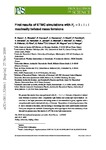First results of ETMC simulations with Nf=2+1+1 twisted mass fermions
| dc.contributor.author | Reker, S | |
| dc.contributor.author | Baron, R | |
| dc.contributor.author | Blossier, B | |
| dc.contributor.author | Boucaud, P | |
| dc.contributor.author | Deuzeman, A | |
| dc.contributor.author | Drach, V | |
| dc.contributor.author | Farchioni, F | |
| dc.contributor.author | Gimenez, V | |
| dc.contributor.author | Herdoiza, G | |
| dc.contributor.author | Jansen, K | |
| dc.contributor.author | Michael, C | |
| dc.contributor.author | Montvay, I | |
| dc.contributor.author | Palao, D | |
| dc.contributor.author | Pallante, E | |
| dc.contributor.author | Pene, O | |
| dc.contributor.author | Urbach, C | |
| dc.contributor.author | Wagner, M | |
| dc.contributor.author | Wenger, U | |
| dc.date.accessioned | 2018-07-25T12:52:42Z | |
| dc.date.available | 2018-07-25T12:52:42Z | |
| dc.date.issued | 2010-06-23 | |
| dc.identifier.issn | 1824-8039 | |
| dc.identifier.uri | http://hdl.handle.net/10026.1/11904 | |
| dc.description | 8 pages, 4 figures. Talk presented at the XXVII International Symposium on Lattice Field Theory, July 26-31 2009, Peking University, Beijing, China | |
| dc.description.abstract |
We present first results from runs performed with Nf = 2+1+1 flavours of dynamical twisted mass fermions at maximal twist: a degenerate light doublet and a mass split heavy doublet. An overview of the input parameters and tuning status of our ensembles is given, together with a comparison with results obtained with Nf = 2 flavours. The problem of extracting the mass of the K-and D-mesons is discussed, and the tuning of the strange and charm quark masses examined. Finally we compare two methods of extracting the lattice spacings to check the consistency of our data and we present some first results of cPT fits in the light meson sector. | |
| dc.format.extent | 104- | |
| dc.language.iso | en | |
| dc.publisher | Sissa Medialab | |
| dc.subject | hep-lat | |
| dc.subject | hep-lat | |
| dc.title | First results of ETMC simulations with Nf=2+1+1 twisted mass fermions | |
| dc.type | conference | |
| dc.type | Conference Proceeding | |
| plymouth.author-url | http://arxiv.org/abs/0911.5244v1 | |
| plymouth.date-start | 2009-07-26 | |
| plymouth.volume | 91 | |
| plymouth.conference-name | The XXVII International Symposium on Lattice Field Theory | |
| plymouth.publication-status | Published | |
| plymouth.journal | Proceedings of The XXVII International Symposium on Lattice Field Theory — PoS(LAT2009) | |
| dc.identifier.doi | 10.22323/1.091.0104 | |
| plymouth.organisational-group | /Plymouth | |
| plymouth.organisational-group | /Plymouth/Faculty of Science and Engineering | |
| plymouth.organisational-group | /Plymouth/Faculty of Science and Engineering/School of Engineering, Computing and Mathematics | |
| plymouth.organisational-group | /Plymouth/REF 2021 Researchers by UoA | |
| plymouth.organisational-group | /Plymouth/REF 2021 Researchers by UoA/EXTENDED UoA 10 - Mathematical Sciences | |
| plymouth.organisational-group | /Plymouth/REF 2021 Researchers by UoA/UoA10 Mathematical Sciences | |
| plymouth.organisational-group | /Plymouth/Users by role | |
| plymouth.organisational-group | /Plymouth/Users by role/Academics | |
| dc.identifier.eissn | 1824-8039 | |
| dc.rights.embargoperiod | Not known | |
| rioxxterms.versionofrecord | 10.22323/1.091.0104 | |
| rioxxterms.licenseref.uri | http://www.rioxx.net/licenses/all-rights-reserved | |
| rioxxterms.type | Conference Paper/Proceeding/Abstract |


